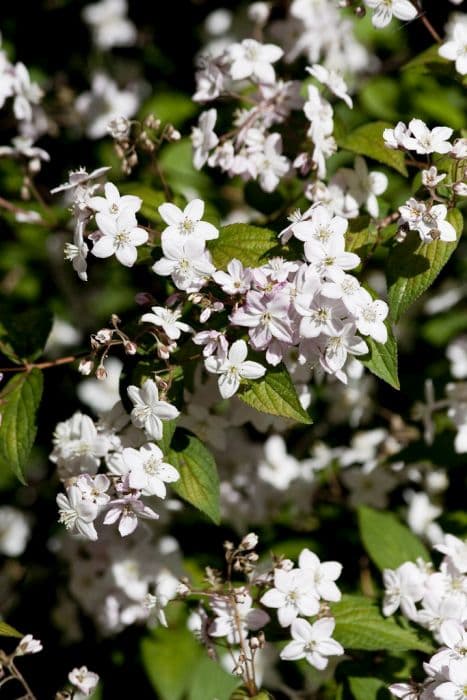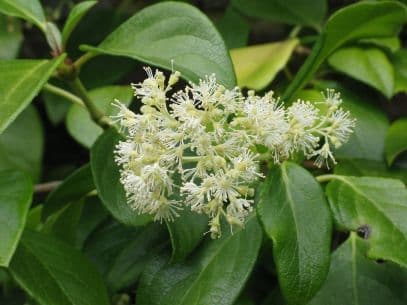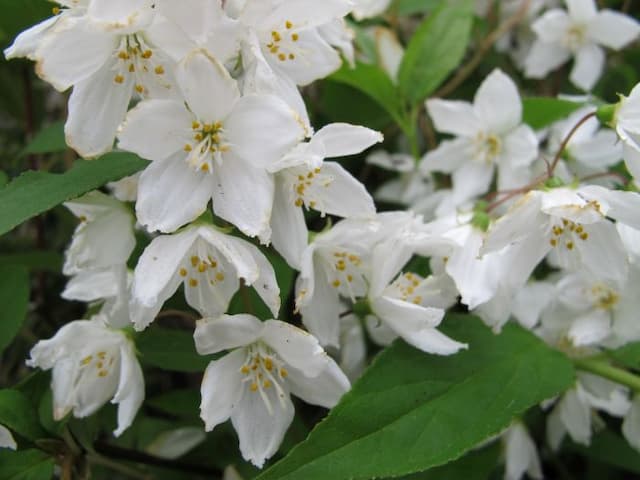Beautiful Deutzia Deutzia pulchra

ABOUT
Deutzia pulchra, commonly known as the beautiful deutzia, is a visually striking ornamental shrub that has a lot to offer in terms of aesthetic appeal. It presents itself with a multitude of arching branches that create an elegant, fountain-like form. These branches are adorned with leaves that exhibit a deep green shade, which serves as a perfect backdrop for its floral display. The leaves of the beautiful deutzia are oval-shaped with serrated edges, and they grow in an opposite pattern on the branches. As the seasons shift, these leaves may take on subtle changes in color, adding to the visual interest of the plant. Springtime is when the beautiful deutzia truly shines, as it becomes covered in clusters of delicate flowers. These blossoms are usually white or a soft shade of pink, depending upon the specific variety. Each flower has a modest yet appealing form, with petals that open wide to welcome pollinators. The texture of the beautiful deutzia's bark adds another layer of allure to this shrub. As the plant matures, the bark may peel or become flaky, providing an interesting contrast to the smoothness of the leaves and the softness of the blossoms. Overall, the beautiful deutzia is a charming shrub that brims with elegance throughout the growing season, with its flower-covered branches in spring and its poised structure year-round.
About this plant
 Names
NamesFamily
Hydrangeaceae
Synonyms
Fuzzy Deutzia, Beautiful Deutzia
Common names
Deutzia discolor, Deutzia purpurascens.
 Toxicity
ToxicityTo humans
Deutzia pulchra, commonly known as Pride of Rochester, is not widely recognized for its toxicity to humans. There is limited information suggesting that it poses significant health risks upon ingestion. However, as with many plants, it is advisable to avoid eating any parts of the plant due to the potential for adverse reactions or digestive discomfort, especially if there is uncertainty about the edibility of the plant or a person has a specific sensitivity to it.
To pets
Deutzia pulchra, also referred to as Pride of Rochester, is not specifically identified as toxic to pets. Nonetheless, the ingestion of plants by pets can sometimes lead to gastrointestinal upset, including symptoms like vomiting and diarrhea. It is generally prudent to prevent pets from eating ornamental plants because different animals can have varying sensitivities and there may also be a lack of detailed information on the plant's potential toxicity. If a pet is observed consuming Pride of Rochester or if there is any concern about symptoms following ingestion, it is recommended to consult with a veterinarian.
 Characteristics
CharacteristicsLife cycle
Perennials
Foliage type
Deciduous
Color of leaves
Green
Flower color
White
Height
6-10 feet (1.8-3 meters)
Spread
4-6 feet (1.2-1.8 meters)
Plant type
Shrub
Hardiness zones
5
Native area
Asia
Benefits
 General Benefits
General Benefits- Aesthetic Appeal: Deutzia pulchra, commonly known as the Beautiful Deutzia, features charming white or pink flowers that enhance the visual appeal of gardens and landscapes.
- Attracting Pollinators: Its blossoms attract bees and butterflies, which are beneficial for pollination in the surrounding environment.
- Low Maintenance: The Beautiful Deutzia is generally easy to care for and does not require intense gardening effort, making it suitable for a variety of gardeners.
- Seasonal Interest: It provides seasonal interest with its spring and early summer blooming period, adding to the variety of a garden's year-round appeal.
- Landscape Usage: The plant can be used in mixed borders, cottage gardens, and as a focal point in floral arrangements due to its shape and size.
- Versatility: Deutzia pulchra can be grown in various soil conditions and is relatively adaptable to different environmental conditions, though it prefers well-drained soils and some sun.
- Biodiversity Support: By providing nectar sources for pollinators, the Beautiful Deutzia contributes to the biodiversity of the area in which it is planted.
- Erosion Control: When planted in groups, its root system can help stabilize the soil and prevent erosion.
 Medical Properties
Medical PropertiesThis plant is not used for medical purposes.
 Air-purifying Qualities
Air-purifying QualitiesThis plant is not specifically known for air purifying qualities.
 Other Uses
Other Uses- Decorative Crafts: The wood of Deutzia pulchra can be used in small-scale decorative crafts due to its fine grain and workability.
- Photography Prop: Its attractive blooms make it a popular choice for use as a natural prop in garden and spring-themed photography sessions.
- Teaching Tool: Botany teachers may use Deutzia pulchra to demonstrate plant growth, flowering patterns, and pollination to students.
- Culinary Garnish: Although not widely known for culinary purposes, the flowers could potentially be used as an edible garnish for their aesthetic appeal.
- Landscape Planning: This plant is used by landscape architects to add a splash of color and to create "rooms" in larger garden designs.
- Fragrance Source: While not a major source of essential oils, the flowers of Deutzia pulchra can be used in potpourri for their light fragrance.
- Basketry: Flexible young stems of Deutzia pulchra might be utilized in weaving small baskets or decorative items.
- Floral Displays: Stems with flowers can be used in floral arrangements and displays for events such as weddings and celebrations.
- Wildlife Shelter: When planted en masse, this shrub can provide excellent shelter and habitat for small wildlife in a garden setting.
- Erosion Control: The plant's root system may help in preventing soil erosion when used in slope stabilization and bank reinforcement projects.
Interesting Facts
 Feng Shui
Feng ShuiThe plant Deutzia is not used in Feng Shui practice.
 Zodiac Sign Compitability
Zodiac Sign CompitabilityThe plant Deutzia is not used in astrology practice.
 Plant Symbolism
Plant Symbolism- Innocence: With its delicate white flowers, Deutzia pulchra often symbolizes purity and the innocence of nature.
- Beauty: The species name 'pulchra' itself means 'beautiful' in Latin, reflecting the aesthetic appeal of the plant.
- New Beginnings: As the plant blooms in the spring, it is frequently associated with renewal and the start of new phases in life.
- Simplicity: Deutzia pulchra's simple and unassuming appearance can represent a love for humble elegance and understated charm.
 Water
WaterWhen watering your Pride of Rochester, or Deutzia pulchra, it is important to water deeply but infrequently to encourage a strong root system. Make sure the soil is moist to a depth of at least 2 inches. During the growing season, water approximately once a week, giving the plant around 1 gallon of water each time. Reduce watering in the dormant winter months to prevent overwatering and root rot. However, adjust the frequency based on local weather conditions – more frequent watering may be necessary during prolonged dry spells or in particularly hot climates.
 Light
LightPride of Rochester flourishes in full sun to partial shade. The ideal spot for this plant is one where it receives at least 4 to 6 hours of direct sunlight daily, with some dappled afternoon shade to protect it from the intense, late-day sun. Avoid placing it in deep shade, as this will reduce flowering and can lead to leggy growth.
 Temperature
TemperaturePride of Rochester is able to withstand a range of temperatures, making it a hardy addition to your garden. This plant can survive in temperatures as low as 20°F and as high as 80°F. However, it thrives best when the temperature ranges between 50°F and 70°F. Keep it protected from harsh winter winds which can damage the plant.
 Pruning
PruningPrune your Pride of Rochester immediately after it finishes flowering to shape the plant and remove any dead or damaged wood. This timing usually falls in late spring or early summer. Pruning encourages healthy new growth and improves air circulation, which helps prevent fungal diseases. Prune about one-third of the oldest canes to the ground annually to promote vigorous growth.
 Cleaning
CleaningAs needed
 Soil
SoilThe best soil mix for the Beautiful Deutzia (Deutzia pulchra) is well-draining, fertile loam with added organic matter. The ideal soil pH should be slightly acidic to neutral, ranging from 6.0 to 7.0. Incorporating compost into the planting mix can enhance soil structure and fertility.
 Repotting
RepottingBeautiful Deutzia (Deutzia pulchra) generally does not require frequent repotting and can be repotted every 2 to 3 years. It is best to repot in the early spring before the onset of new growth.
 Humidity & Misting
Humidity & MistingBeautiful Deutzia (Deutzia pulchra) prefers moderate humidity levels. To maintain optimal conditions, aim for a humidity level between 40% and 60%.
 Suitable locations
Suitable locationsIndoor
Place Beautiful Deutzia in bright, indirect light indoors.
Outdoor
Plant Beautiful Deutzia in partial shade outdoors.
Hardiness zone
5-8 USDA
 Life cycle
Life cycleThe Deutzia pulchra, commonly known as the "Pride of Rochester," begins its life cycle from seeds that germinate in moist, well-drained soil, ideally in areas with partial to full sun exposure. After germination, it develops into a young plant with foliage, establishing a root system and starting vegetative growth. As the plant matures, it enters the vegetative stage where it develops its characteristic lance-shaped leaves and woody stems. Following this period of growth, it reaches the flowering stage usually in late spring to early summer, producing clusters of fragrant, star-shaped white flowers attractive to pollinators. After pollination, the flowers develop into small capsule-like fruits containing seeds, which eventually disperse to begin a new cycle. In winter or the dormant season, the plant may lose its leaves, conserving energy until the conditions favor growth in the next cycle.
 Propogation
PropogationPropogation time
Spring to early summer
Deutzia pulchra, commonly known as the Fuzzy Deutzia, is best propagated in the late winter to early spring just before new growth begins. The most popular method of propagation for this plant is softwood cuttings. To propagate via softwood cuttings, select a healthy stem from the current year’s growth and cut a 4 to 6 inch (10 to 15 cm) piece, making sure there are at least two to three pairs of leaves. Remove the leaves from the bottom half of the cutting and dip the cut end in rooting hormone to encourage root development. The cutting should then be inserted into a pot filled with a moistened mixture of half peat and half perlite or sand. It’s crucial to maintain a humid environment around the cutting by covering the pot with a plastic bag or placing it in a cold frame. Roots typically develop within a few weeks, after which the new Fuzzy Deutzia plants can be transplanted to their final location.



![Hydrangea [Pink Annabelle] ('Ncha1')](/_next/image?url=https%3A%2F%2Fplants-admin.emdemapps.com%2Fimages%2Fplants%2F%2Fimages%2F604b576c63619.png&w=640&q=75)





